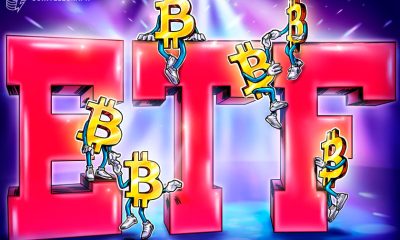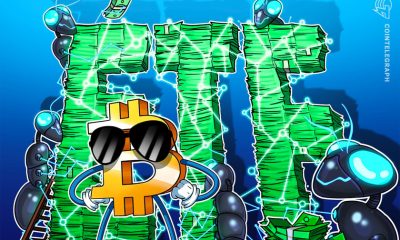Bitcoin
Game theory meets DeFi: Bouncing ideas around tokenomic design

“If you look at financial structures in history, everything worked out because of collaboration.”
Jack Lu, 23, was struck by the idea for his new DeFi platform Bounce while working on his thesis on game theory and cryptocurrency at Reed College in California.
“It took me quite a long time to think of it,” Lu explains about his game theory influenced auction platform. “Everyone was talking about lending and borrowing, and doing Uniswap and providing liquidity. When I looked at this financial channel I think there’s one missing piece, which is auctions.”
Lu — who counts Andre Cronje from Yearn.Finance, Kain Warwick from Synthetix and Calvin Liu from Compound as peers — describes Bounce as a decentralized version of eBay, Sotheby’s or Christies. Users can set up pools to auction off tokens, and play around with parameters like the number to be swapped, the time limit and different ways of accepting bids.
He co-founded it with Ankr CEO Chandler Song and the bare bones, black and white platform went live on August 4. “I partnered with some friends and we made it,” Lu says. “The platform has been live for two months and it’s ranked nine on ETH gas station.”
So far more than 2,700 pools have been created, and more than 500,000 Ether ($179M) has changed hands on the Ethereum version of the platform. Bounce was also one of the first five projects announced for the interoperable Binance Smart Chain — which is essentially an Ethereum clone with lower gas fees and avoid congestion — and 700,000 BNB ($18.5M)has been swapped on that version since early September too.
The site launched with two types of auctions. Fixed swap, where everyone has the same price (like an ICO from 2017) and sealed bid auctions.
“You can put in a floor price and a timer and anyone can come and bid above the floor price. And when the pool closes, the smart contract will fill the orders from the highest price down to the bottom. So people do get different prices.”
Lu recently added in some variations on Dutch style auctions — which start from a high price and sell off the tokens gradually as the price comes down — as well as English auctions, which start from a reserve price and head up.
World tour before San Francisco
Originally from Guangdong Province in China, Lu attended high school in Britain where he took intro courses for college economics that enabled him to finish his degree atReed College early. “That was where Steve Jobs went,” says Lu. It was there he discovered crypto in 2016.
“Quite a lot of teenagers got into crypto at the time and my college roommate taught me about Ethereum and then I started to read medium articles and Reddit,” he says. Lu began joining crypto groups and became friendly with NEO founder Hongfei Da which led to a six month internship with NGC Ventures in Shanghai in 2018.
It turned into a full-time gig after he graduated in 2019 and he’s now the US Investment Manager for the fund, based in San Francisco.
“I help our portfolio projects to design their tokenomics,” he says. “During my due diligence on many projects, I have a broader view on what’s going on in the crypto market and what the progress is on tokenomics in the crypto world.”
Learning to play games
He may be the youngest employee at the firm, but he’s also the only one to have written his thesis on blockchain and game theory — one of just a handful on the subject in the world at the time.
Game theory is a branch of mathematics that examines the strategies employed in competitive situations where the outcomes for players depend critically on the actions of the other players. It has been applied to everything from war, to business and biology, but Lu’s thesis explores why it’s a perfect fit for cryptocurrencies. The ‘players’ in the decentralized world of blockchain, from miners to traders and hackers, are independent and make decisions after evaluating the benefits and costs associated with their moves.
Unlike in the real world (as theNew Yorker points out), game theory actually works better when applied to blockchain and smart contracts, because the rules are fixed, the blockchain is transparent and the information can be made available to all the players. Research has shown that the more informed party in a deal typically captures up to 18% more economic benefits than the less informed party. Lu explains:
I always say it’s a successful experiment in game theory since we use smart contracts to avoid a lot of human elements for a game, and we can see how pool creators and participants act.
His thesis examined concepts like theNash Equilibrium, which is used to analyze the outcome of games where there is a strategic interaction between several decision makers and where the outcome for each depends on the decisions others make, as well as their own.
Snitches get four years
The famous example of thePrisoner’s Dilemma helps illustrate the concept:
Two suspects are interrogated separately for a crime. If both confess, they get four years in jail. If neither does, each will be sentenced to two years in jail. If only one confesses he will be released and the other sentenced to six years.
The best outcome is that neither of them confess. However, the model predicts both will confess, because they don’t have any information about what the other prisoner is doing and thus hedge their bets and both converge at the middle outcome.
Game theory gets fantastically complicated very quickly with games within games, and various amounts of knowledge and information about what other players are up to, expressed using algebraic formulas.
Lu enjoys watching the auctions on Bounce to observe how things play out in the context of game theory. “I think all types of auctions are game theory events,” he says pointing out that a sealed bid auction is reminiscent of the Prisoner’s Dilemma.
“If you raise (the price), everyone needs to pay more than the sealed bid creator’s floor price. But if everyone bids near the floor price, everyone would be better off. So I think this kind of on-chain behavior is quite interesting to see.”
Price discovery
Lu says that auctions provide a better route towards price discovery for Initial DEX offerings than exchanges, or automated market makers like Uniswap. where the mechanics of competition encourages a lot of quick and reactive price action.
“For Bounce if you’re doing an auction, people have time to think. And the projects also have time to think and analyze people’s demand for each pool,” he says. “There’s only a floor price or a price ceiling, so everything else is purely based on market demand.”
“Some projects are doing consecutive sealed bid auctions and the final price for each round is different. Like in the first round the final executed price is high and in the second round, the price is lower, and then in the third round the price gets higher again. So I think this is very interesting for analyzing players.”
He compares it to a guessing game, where players in the second round assume that because there’s more supply after the first round, they can enter at a lower price, but in the third round they assume everyone else will bid lower again, so en masse they bid higher in order to ensure they get tokens. As he puts it:
If you think that way others will also think that way, so this is the pattern of a consecutive game in game theory.
Synthetix founder Kain Warwick says Bounce offers some intriguing possibilities.
“On-chain price discovery mechanisms are still fairly rudimentary for early stage projects with low liquidity,” he says. “Bounce is looking to create several new token distribution mechanisms which will significantly improve price discovery and reduce volatility. Synthetix is exploring using this mechanism as part of our [stablecoin] sUSD peg stabilisation efforts.”
Synthetix is expected to make a proper announcement about that soon.
Another use case for Bounce is for decentralized over the counter (OTC) trades. Users with large piles of tokens can set up a pool, either privately or publicly, to arrange an OTC deal and avoid the price slippage that would occur on a centralized exchange.
Around 50 IDOs and OTC trades have already made use of the platform. Bounce hit a milestone when Lu added support for non-fungible tokens. NFTs are unique tokens that first appeared in the form of CryptoKitties, but now represent ownership of digital art, fashion, unique in-game items like F1 cars in racing games, and sporting memorabilia collectibles.
“I think an English auction is a perfect solution for NFTs that are art or tools in a game. But there are more functionalities, like using NFTs as collateral or NFTs as a loan, so for that dutch and sealed bid auctions have some special use cases.”
Competition for auctions
Bounce isn’t the only token auction platform and has competition in the form ofMesa, which is currently in beta, andCoinList. But Lu argues that Bounce is more decentralized than either.
“The difference is the philosophy, I want everything to be on chain, I want zero (off chain) computation, which means the smart contract will do everything,” he says. “It requires the smart contracts to be lightweight and requires your data type to be very efficient because you can only do a limited amount of computation on chain.”
Game theory was also influential when Lu designed the tokenomics for the project. While he has studied lots of complicated token systems in the course of his work, he decided to start small.
“It’s impossible to create a perfect game at the beginning because every single game you cannot reach equilibrium immediately,” he explains — which in this case means an optimal outcome. “A lot of projects think they can which is why they build a very, very complex token economy.” He explains that:
For game theory you move to your equilibrium gradually and that’s how I designed the Bounce tokenomics
Lu started with daily rewards based on the number transactions, then added staking and Uniswap liquidity pool rewards and more.
“For me the philosophy is we will build more token economic pieces along the road, not at the very beginning, because even if you build a very complex system, if there are no people participating and you don’t see what people want, then you are far away from equilibrium.”
Attack of the scammers
Being philosophically inclined towards maximum decentralization, Lu was faced with a tricky situation when scams started appearing on the platform. This is an issue that plagues DeFi protocols with a host of scam tokens listed on Uniswap every week.
“People are saying ‘Oh you should ban scammers’, but I was like, ‘Oh this is a dilemma, because if I ban the scammers that means this platform is no longer decentralized,” he says.
“How can you define if it is real or if it’s fake?” he says. “So the only way is to build a social trust system.”
In the just released system, users stake BOT tokens, and can then propose a project to the social trust board. The community of stakers vote on which tokens are legit and which aren’t. So far around ten proposals have been put to a vote.
“The proposer (of a pool) will stake their token to make sure they have their monetary interest in it. And they can lay out all of the project’s information and all the Bounce holders can go to this social trust board and open all the proposals and if they like it, they can upvote, if they don’t like they can downvote.”
Interestingly enough, it’s not based on the similar sounding Kleros curated token registry for Uniswap, which takes advantage of a game theory concept called a Schelling Point to reward jurors with tokens for voting for the judgement they think most other jurors are likely to give and punish them for voting any other way.
“Right now there’s not a mechanism, but later there will be punishments, Lu says of the social trust system. “When you propose a pool you’ll stake tokens in an insurance fund and the mechanism will punish malicious behaviour. If everything is clear, you get the insurance back, otherwise you compensate people through the insurance fund.”
“I think this is going to be a very nice experiment. When people talk about DeFi governance everyone just focuses on parameters like changing the transaction fee from this percentage to that percentage and adding a new pair. But this is not all that governance is about, there should be a large, large social element and people should be able to use tokens to do some interesting stuff. If on Bounce, social trust is worked out, I hope other people can also try to use it.”
Attack of the clones
The other big issue DeFi projects face is that as soon as a successful protocol is created, someone else clones it and offers its users bigger incentives to jump ship. Lu says he’s just happy if “there are more people starting to think of different types of auctions and start to start to see this is also a DeFi piece that people can work on” and isn’t worried about clones.
“Being the creator of this idea, I know exactly what I’m doing,” he says. “They might be able to copy the auction types I built but I have a roadmap in mind to follow so I think we can gradually compete them out.
“You can copy one piece of the framework but when the framework has a solid foundation and a community to back it, I don’t think a copycat will function. “
Governance for Bounce is handled by an all-star line up including Liu (Compound), Warwick (Syntherix) Stani Kulechov (Aave), George Lambeth (Balancer), Nikita Ovchinnik (1inch) and Michael Gu (Boxmining). Lu says that he hopes to collaborate more with these projects and believes that interoperability and collaboration is the key to DeFi’s future.
“The next step will be to find cooperation with other DeFi projects because I strongly think we only need one financial channel and everyone needs to cooperate with each other – not to have the ambition to fork other people,” he says.
If you look at financial structures in history everything worked out because of collaboration.

















